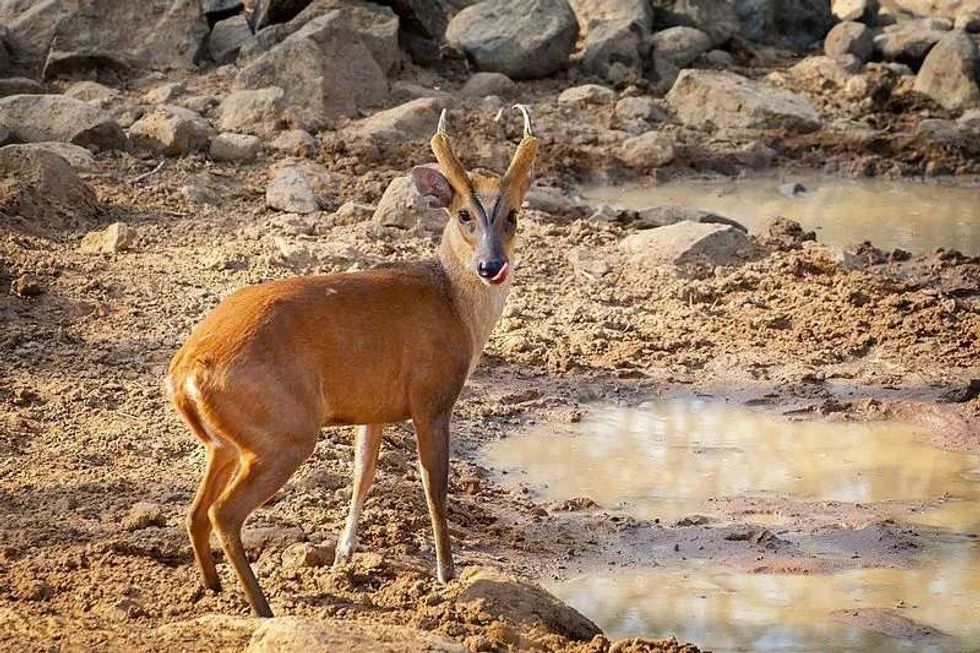The Muntjac (munt-JAK) is the name of a deer species derived from the Latinized form of the Dutch 'muntak'. They are native to Asia and are mainly found in India, Vietnam, Myanmar, Srilanka, and the lower part of the Himalayas.
A population of Muntiacus reevesi lives in the UK and a few parts of Japan and these mammals are also known as barking deer or rib-faced deer,
Muntjacs eat grass, greens, sprouts, and fruits and their favorite food is raspberry. Males have tiny, straight antlers that can re-grow during autumn. They use these antlers for their self-protection.
They are brown and can vary from deep brown to yellowish-brown. They also have broad, flat tails.
Indian Muntjacs are also known as barking deer as they make an alarming sound similar to a dog when in danger. Both males and females of Indian Muntjacs have dark pouches under their eyes which are scent glands. They use these for communicating with each other.
The Muntjac deer species comes under the Least Concern category of conservation. It is a not-extinct species, and its population is growing significantly. If you like these Muntjac deer facts, you can also check out the articles on Key deer and White-tailed deer.
Muntjac Interesting Facts
What type of animal is a Muntjac?
Muntjac deer, referred to as barking deer or rib-faced deer, are small deer of a brownish color, belonging to the Muntiacus genus. They are energetic at night and asleep during the daytime.
The kingdom, phylum, class, order, and genus of Muntjacs are Animalia, Chordata, Mammalia, Artiodactyla, and Muntiacus. Males have antlers, whereas females only have tiny bones in place of antlers.
Their canine teeth which are pointing downward are known as Muntjac deer tusks. These canine teeth are unique to the Muntjac and are a differentiating factor between a Muntjac and a native deer.
What class of animal does a Muntjac belong to?
Muntjac deer belong to the class of Mammalia.
How many Muntjacs are there in the world?
There are 13 different types of Muntjac deer species as per the IUCN. The Indian Muntjac, Chinese Muntjac, and leaf Muntjac are a few of the most popularly known species.
Where does a Muntjac live?
Muntjac deer live in thick meadows in medium to high-density forests. They are spread across southeast Asia, China, the UK, India, and France.
What is a Muntjac's habitat?
A Muntjac's preferred habitat is dense greenery, dense forest areas, and grassy fields. They are earthbound and prefer to stay adjacent to water. A few species live in the land surrounding tall hills.
Who do Muntjacs live with?
Muntjacs prefer to stay alone. However, a male and female or a female and her offspring can pair up sometimes.
How long does a Muntjac live?
A male can live up to 16 years, whereas a female can live up to 19 years.
How do they reproduce?
Female Muntjacs attain sexual maturity once they become one year old and breeding is not constrained to any particular time of year because they have their estrous cycles all through the year. Each estrous cycle spans between 14 to 21 days and lasts for two days.
Therefore, the gestation period is between 180 to 220 days. They usually give birth to one kid at a time and, very rarely, they can give birth to twins.
What is their conservation status?
Muntjacs are not extinct, and their population has recorded fast expansion in recent decades. Hence they are considered to be in the Least Concern category.
Muntjac Fun Facts
What do Muntjacs look like?
It is a tiny deer that is brown colored, has dark lines on its face, sharp antlers (male), and lots of fur (female). Its upper canine teeth are known as tusks, and these are 2.8 in (7 cm) long for females and 2 in (5 cm) long for males.
They are found under their lip. Their eyes are situated on both sides of their skull to cover a broader range of sight to identify predators quickly.
How cute are they?
They look charming due to their brownish color, curved appearance, and striped faces.
How do they communicate?
They use auditory communication with each other. They also leave scent marks on plants while entering a territory.
How big is a Muntjac?
At 16 - 26 in (40 - 65 cm) tall, Muntjacs are about the same size as a medium dog, like a Labrador.
How fast can a Muntjac run?
Muntjac deer can run at 30-35 mph (48-56 kph).
How much does a Muntjac weigh?
The weight of Muntjacs varies depending on the subspecies. The typical weight of the Reeves's or Chinese Muntjac is 22 - 40 lb (10-18 kg), and the Indian Muntjac (barking deer) weighs 40 lb (19 kg).
Fea's Muntjac weighs 46 lb (21 kg), the Bornean yellow weighs 41 lb (20 kg), and the giant Muntjac is the largest one, weighing 81 lb (37 kg).
What are the male and female names of the species?
Muntjac males are called bucks, and females are called does.
What would you call a baby Muntjac?
Baby Muntjacs are called fawns.
What do they eat?
Muntjacs eat leaves, seeds, fruits, eggs of birds, and tiny animals. They also eat carrion.
Are they aggressive?
Males (bucks) are not very aggressive and prefer to live in separate zones as much as possible. While they tend to be able to adjust to other Muntjacs, they do fight over females sometimes.
Antlers are their primary fighting weapon and can cause severe wounds to opponents during self-protection. Females (does) are also not very aggressive and do not have any antlers. Therefore, they are not dangerous to humans.
Would they make a good pet?
Leaf muntjacs and Reeve’s Muntjacs, which are the smallest, are the most preferred Muntjac deer pet subspecies, over other subspecies of Muntjacs. They are adoring, mischievous, and caring and they sometimes give kisses too. Initially, they might be a little shy and extra-cautious, but they tend to become more affectionate over time.
Did you know...
Indian Muntjacs, fondly known as barking deer, are unique mammals with regards to their genetics by having a lower diploid chromosome count (a male will have seven whereas a female will have only six). On the other hand, the Muntiacus reevesi, also known as the Chinese Muntjac, has a 46 diploid chromosome count.
Are Muntjacs considered pests?
Muntjac could potentially be a devastating animal pest in Britain as they are destructive to woodland and young trees. When they are found in huge counts, they can also attack cereal crops.
One of the best Reeve's Muntjac fun facts is that the Reeve's Muntjac can be an impactful pest in woodlands and gardens. They are also powerful enough to get through solid fences and barriers.
Different Types Of Muntjac
The Muntiacus reevesi also called the Chinese Muntjac, is seen mostly in southern China and Taiwan. The Chinese Muntjac looks reddish-brown and has striped markings on its face.
Indian Muntjacs (Muntiacus muntjak), also known as barking deer, are native to southern and southeast Asia. They have dark faces, and dense coats, and live in cooler habitats. The leaf Muntjac is the smallest of all Muntjacs and is seen in the thick forests of Myanmar.
They like to roam alone in general, and their descendants don't have any spots. The Bornean yellow, black, hairy-fronted, Fea's, PuHoat, Troung son, Gongshan, and Roosevelt's are some other notable sub-species of deer under the Muntjac species.
Here at Kidadl, we have carefully created lots of interesting family-friendly animal facts for everyone to discover! For more relatable content, check out these Spiral-horned antelope facts and Addax facts for kids.
You can even occupy yourself at home by coloring in one of our free printable Muntjac coloring pages.










